Page 68 of 493
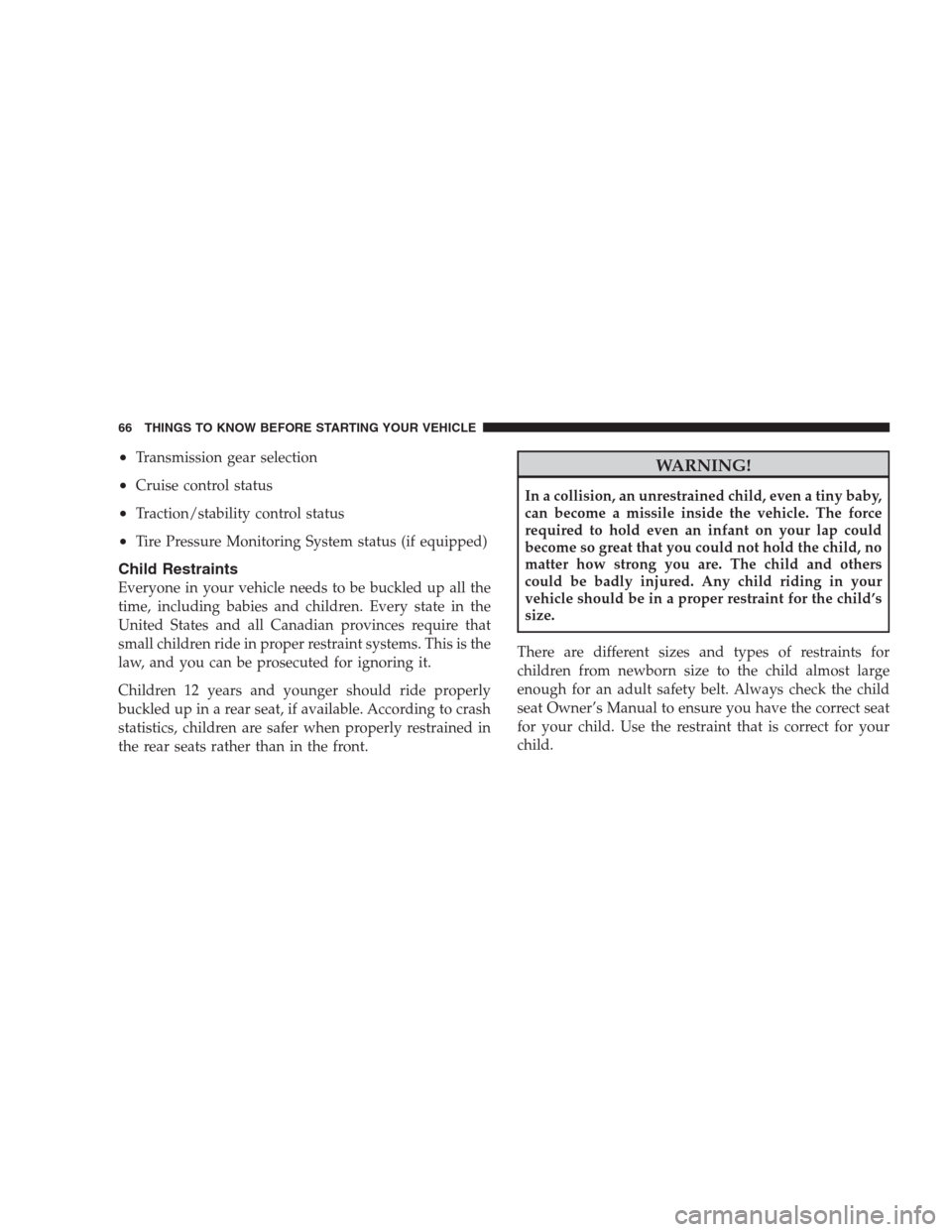
•Transmission gear selection
•Cruise control status
•Traction/stability control status
•Tire Pressure Monitoring System status (if equipped)
Child Restraints
Everyone in your vehicle needs to be buckled up all the
time, including babies and children. Every state in the
United States and all Canadian provinces require that
small children ride in proper restraint systems. This is the
law, and you can be prosecuted for ignoring it.
Children 12 years and younger should ride properly
buckled up in a rear seat, if available. According to crash
statistics, children are safer when properly restrained in
the rear seats rather than in the front.
WARNING!
In a collision, an unrestrained child, even a tiny baby,
can become a missile inside the vehicle. The force
required to hold even an infant on your lap could
become so great that you could not hold the child, no
matter how strong you are. The child and others
could be badly injured. Any child riding in your
vehicle should be in a proper restraint for the child’s
size.
There are different sizes and types of restraints for
children from newborn size to the child almost large
enough for an adult safety belt. Always check the child
seat Owner’s Manual to ensure you have the correct seat
for your child. Use the restraint that is correct for your
child.
66 THINGS TO KNOW BEFORE STARTING YOUR VEHICLE
Page 83 of 493
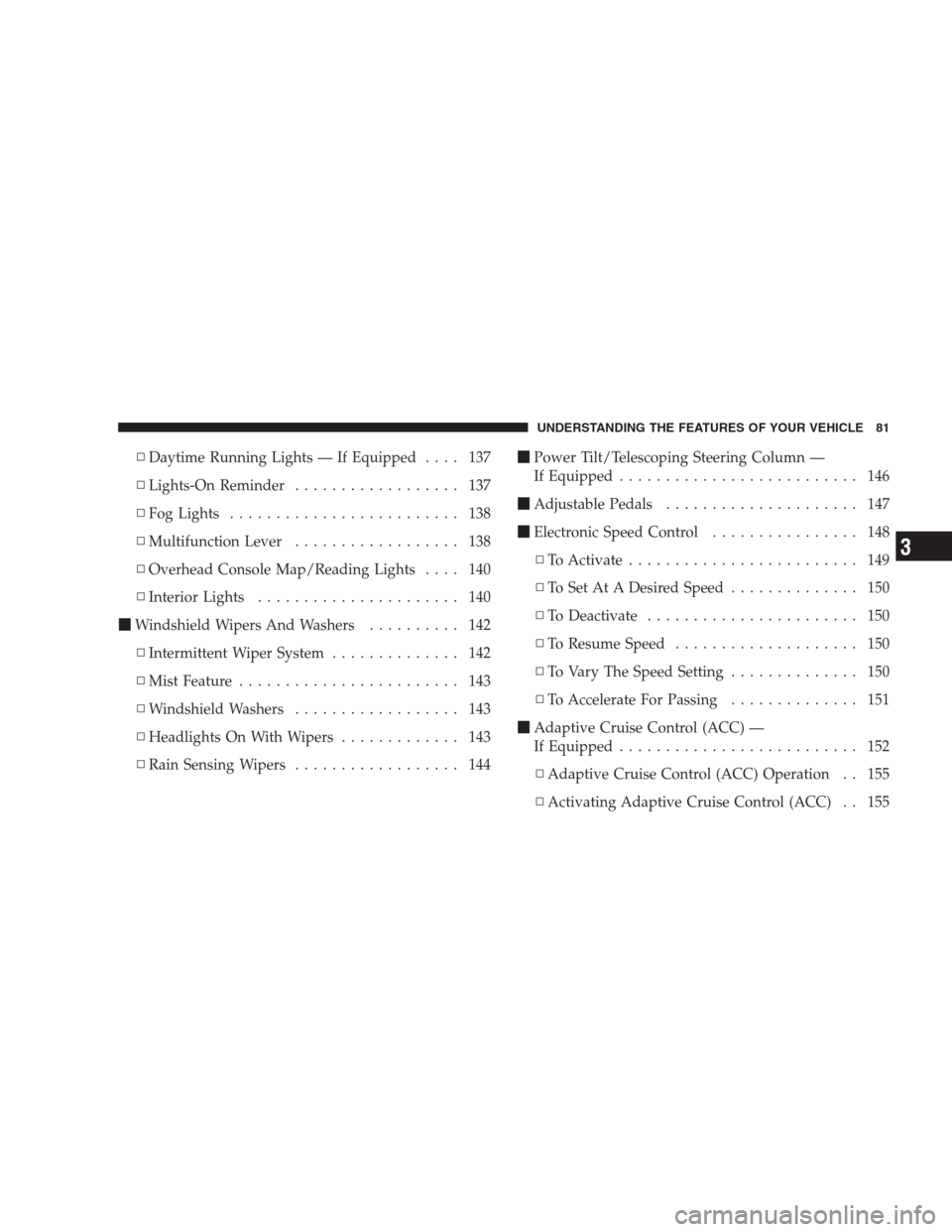
▫Daytime Running Lights — If Equipped.... 137
▫Lights-On Reminder.................. 137
▫Fog Lights......................... 138
▫Multifunction Lever.................. 138
▫Overhead Console Map/Reading Lights.... 140
▫Interior Lights...................... 140
�Windshield Wipers And Washers.......... 142
▫Intermittent Wiper System.............. 142
▫Mist Feature........................ 143
▫Windshield Washers.................. 143
▫Headlights On With Wipers............. 143
▫Rain Sensing Wipers.................. 144�Power Tilt/Telescoping Steering Column —
If Equipped.......................... 146
�Adjustable Pedals..................... 147
�Electronic Speed Control................ 148
▫To Activate......................... 149
▫To Set At A Desired Speed.............. 150
▫To Deactivate....................... 150
▫To Resume Speed.................... 150
▫To Vary The Speed Setting.............. 150
▫To Accelerate For Passing.............. 151
�Adaptive Cruise Control (ACC) —
If Equipped.......................... 152
▫Adaptive Cruise Control (ACC) Operation . . 155
▫Activating Adaptive Cruise Control (ACC) . . 155
UNDERSTANDING THE FEATURES OF YOUR VEHICLE 81
3
Page 84 of 493
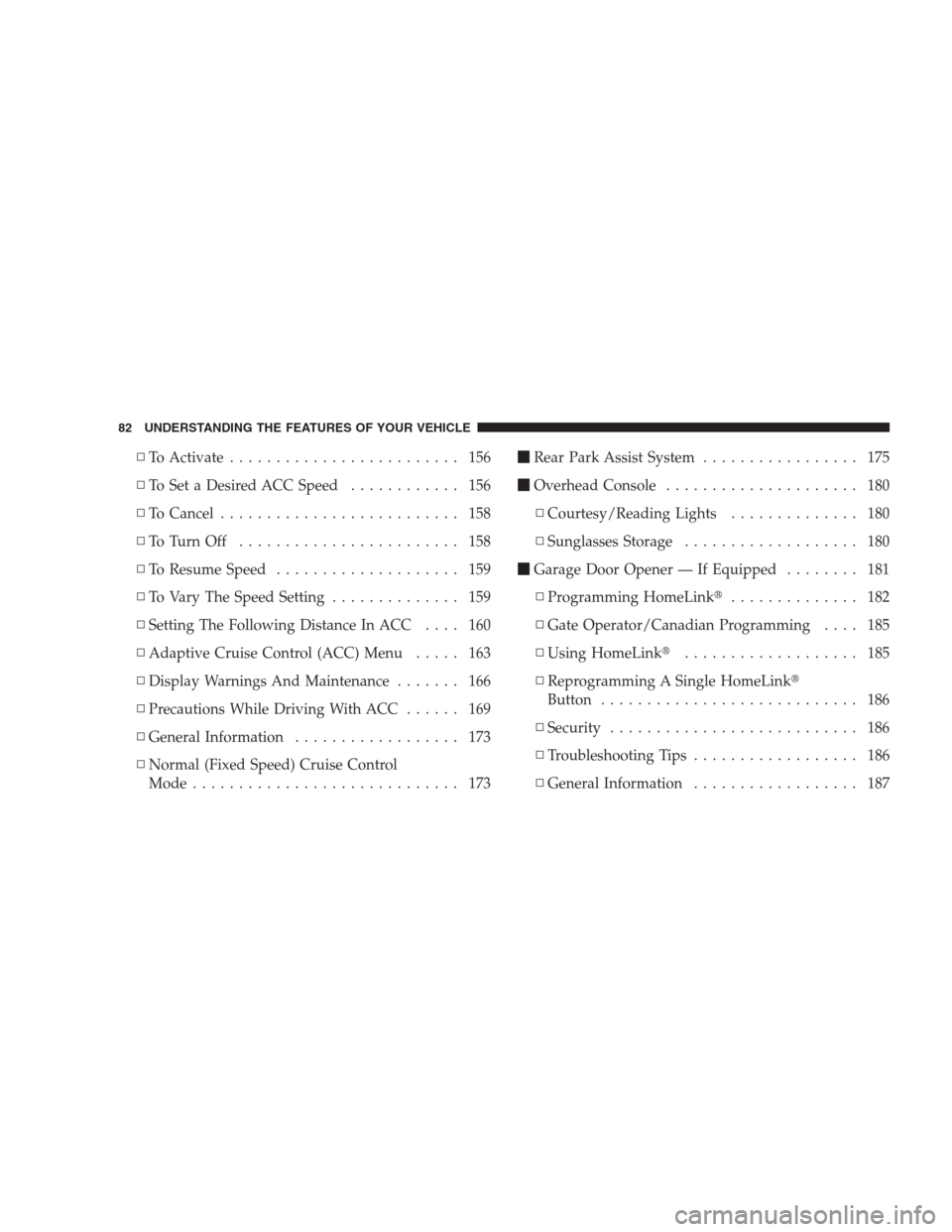
▫To Activate......................... 156
▫To Set a Desired ACC Speed............ 156
▫To Cancel.......................... 158
▫ToTurnOff ........................ 158
▫To Resume Speed.................... 159
▫To Vary The Speed Setting.............. 159
▫Setting The Following Distance In ACC.... 160
▫Adaptive Cruise Control (ACC) Menu..... 163
▫Display Warnings And Maintenance....... 166
▫Precautions While Driving With ACC...... 169
▫General Information.................. 173
▫Normal (Fixed Speed) Cruise Control
Mode............................. 173�Rear Park Assist System................. 175
�Overhead Console..................... 180
▫Courtesy/Reading Lights.............. 180
▫Sunglasses Storage................... 180
�Garage Door Opener — If Equipped........ 181
▫Programming HomeLink�.............. 182
▫Gate Operator/Canadian Programming.... 185
▫Using HomeLink�................... 185
▫Reprogramming A Single HomeLink�
Button............................ 186
▫Security........................... 186
▫Troubleshooting Tips.................. 186
▫General Information.................. 187
82 UNDERSTANDING THE FEATURES OF YOUR VEHICLE
Page 150 of 493
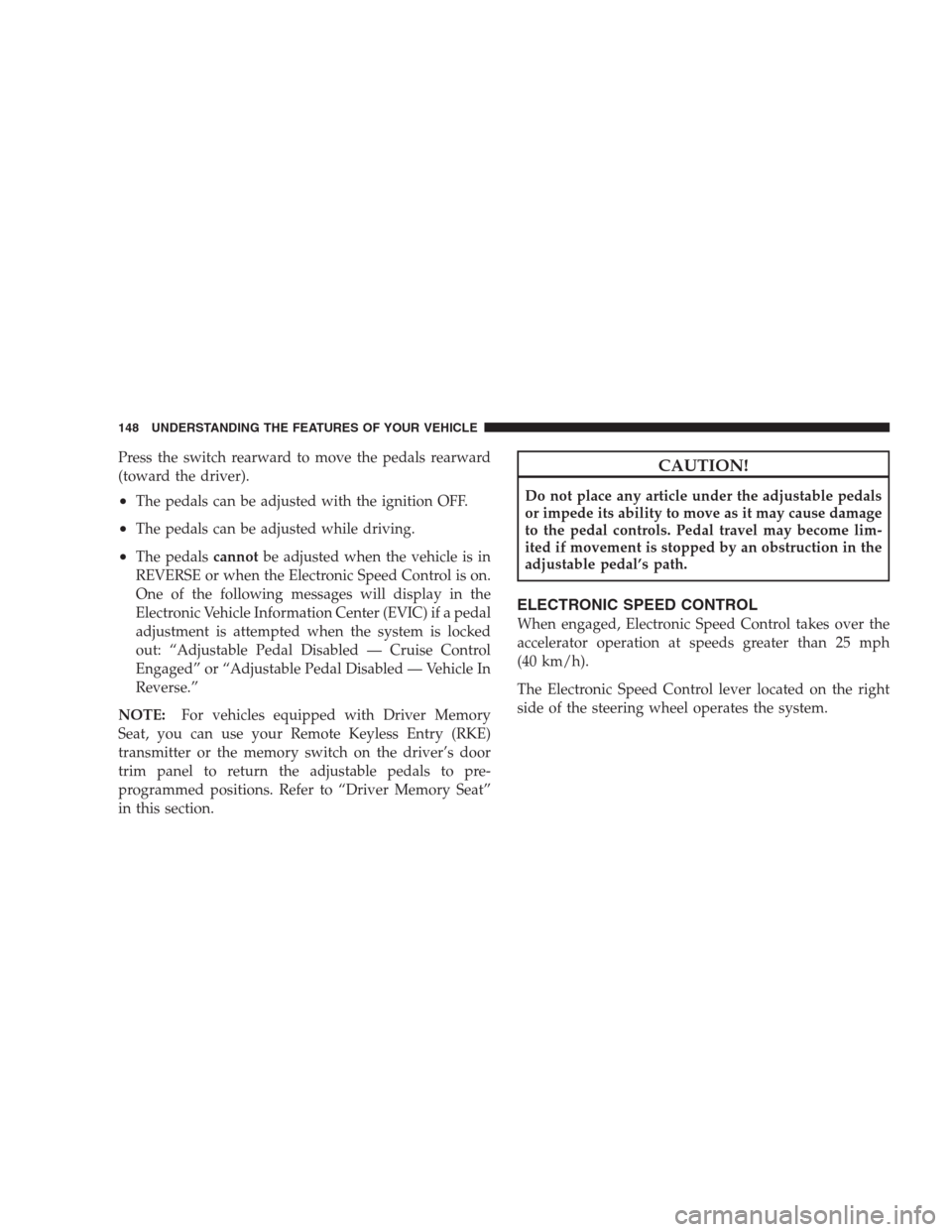
Press the switch rearward to move the pedals rearward
(toward the driver).
•The pedals can be adjusted with the ignition OFF.
•The pedals can be adjusted while driving.
•The pedalscannotbe adjusted when the vehicle is in
REVERSE or when the Electronic Speed Control is on.
One of the following messages will display in the
Electronic Vehicle Information Center (EVIC) if a pedal
adjustment is attempted when the system is locked
out: “Adjustable Pedal Disabled — Cruise Control
Engaged” or “Adjustable Pedal Disabled — Vehicle In
Reverse.”
NOTE:For vehicles equipped with Driver Memory
Seat, you can use your Remote Keyless Entry (RKE)
transmitter or the memory switch on the driver’s door
trim panel to return the adjustable pedals to pre-
programmed positions. Refer to “Driver Memory Seat”
in this section.
CAUTION!
Do not place any article under the adjustable pedals
or impede its ability to move as it may cause damage
to the pedal controls. Pedal travel may become lim-
ited if movement is stopped by an obstruction in the
adjustable pedal’s path.
ELECTRONIC SPEED CONTROL
When engaged, Electronic Speed Control takes over the
accelerator operation at speeds greater than 25 mph
(40 km/h).
The Electronic Speed Control lever located on the right
side of the steering wheel operates the system.
148 UNDERSTANDING THE FEATURES OF YOUR VEHICLE
Page 154 of 493

WARNING!
Electronic Speed Control can be dangerous where the
system cannot maintain a constant speed. Your ve-
hicle could go too fast for the conditions and you
could lose control. An accident could be the result.
Do not use Electronic Speed Control in heavy traffic
or on roads that are winding, icy, snow-covered or
slippery.
ADAPTIVE CRUISE CONTROL (ACC) — IF
EQUIPPED
Adaptive Cruise Control (ACC) increases the driving
convenience provided by cruise control while traveling
on highways and major roadways. However, it is not a
safety system and not designed to prevent collisions.ACC will allow you to keep cruise control engaged in
light to moderate traffic conditions without the constant
need to reset your cruise control. ACC utilizes an infrared
sensor designed to detect a vehicle directly ahead of you.
NOTE:
•If the sensor does not detect a vehicle ahead of you,
ACC will maintain a fixed set speed.
•If the ACC sensor detects a vehicle ahead, ACC will
apply limited braking or acceleration automatically to
maintain a preset following distance, while matching
the speed of the vehicle ahead.
152 UNDERSTANDING THE FEATURES OF YOUR VEHICLE
Page 155 of 493
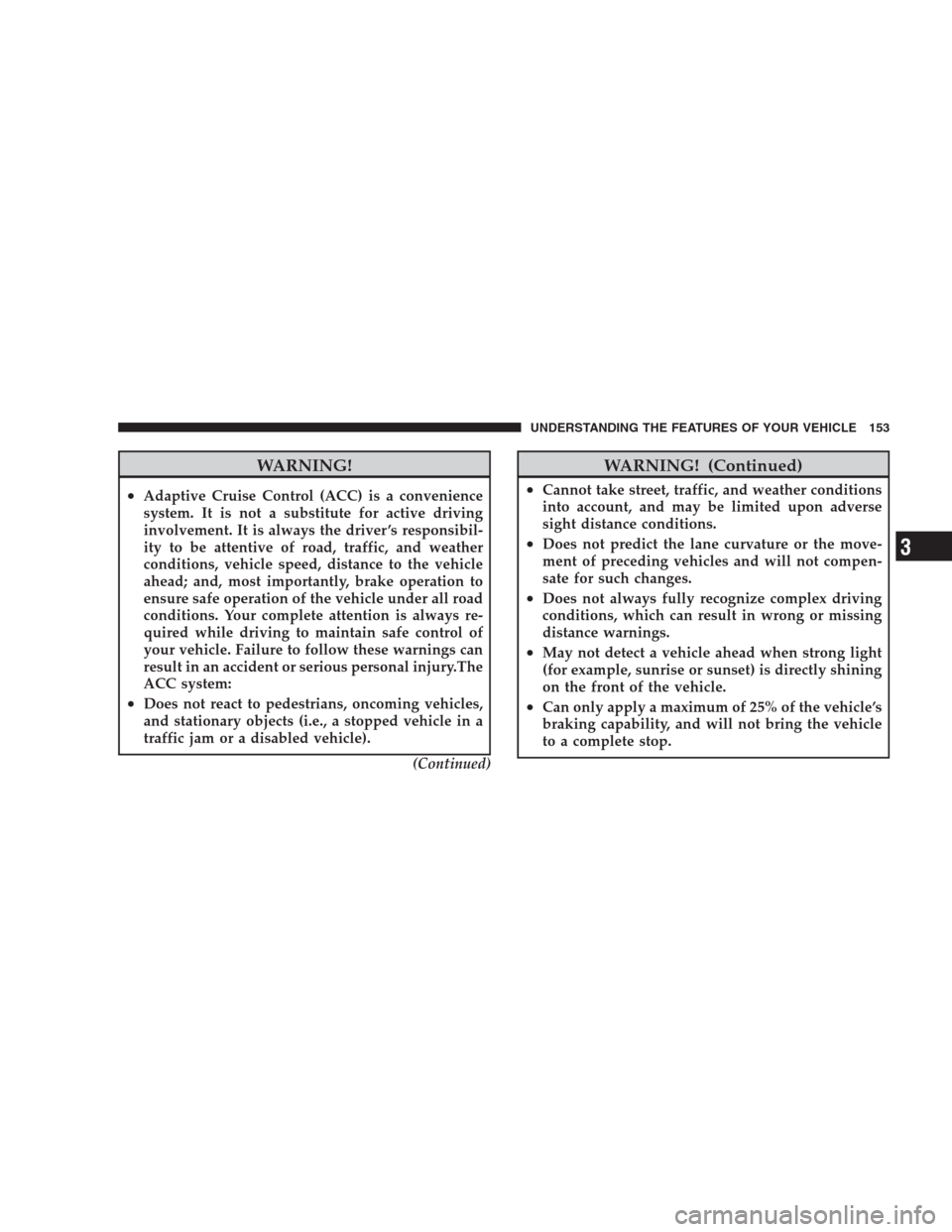
WARNING!
•Adaptive Cruise Control (ACC) is a convenience
system. It is not a substitute for active driving
involvement. It is always the driver ’s responsibil-
ity to be attentive of road, traffic, and weather
conditions, vehicle speed, distance to the vehicle
ahead; and, most importantly, brake operation to
ensure safe operation of the vehicle under all road
conditions. Your complete attention is always re-
quired while driving to maintain safe control of
your vehicle. Failure to follow these warnings can
result in an accident or serious personal injury.The
ACC system:
•Does not react to pedestrians, oncoming vehicles,
and stationary objects (i.e., a stopped vehicle in a
traffic jam or a disabled vehicle).
(Continued)
WARNING! (Continued)
•Cannot take street, traffic, and weather conditions
into account, and may be limited upon adverse
sight distance conditions.
•Does not predict the lane curvature or the move-
ment of preceding vehicles and will not compen-
sate for such changes.
•Does not always fully recognize complex driving
conditions, which can result in wrong or missing
distance warnings.
•May not detect a vehicle ahead when strong light
(for example, sunrise or sunset) is directly shining
on the front of the vehicle.
•Can only apply a maximum of 25% of the vehicle’s
braking capability, and will not bring the vehicle
to a complete stop.
UNDERSTANDING THE FEATURES OF YOUR VEHICLE 153
3
Page 156 of 493
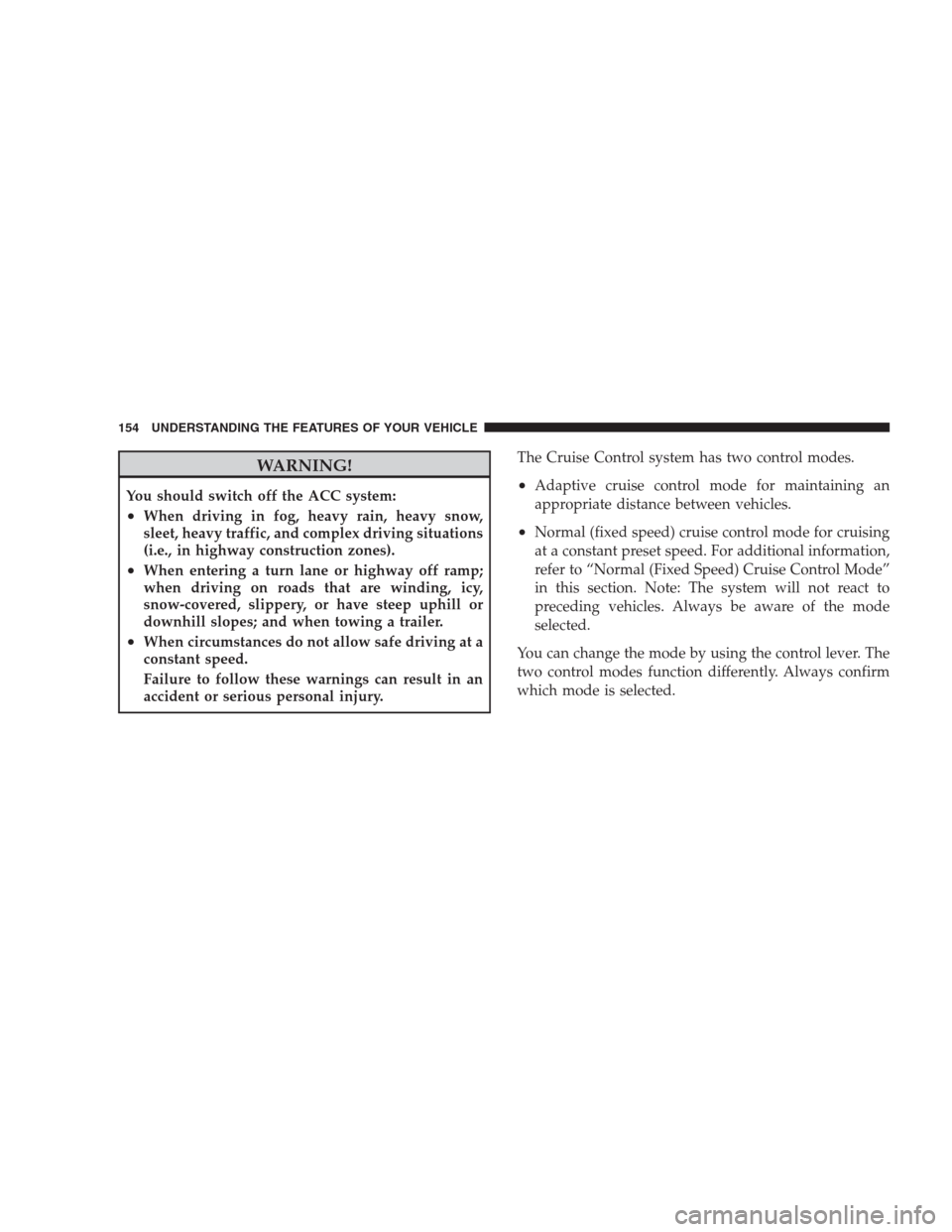
WARNING!
You should switch off the ACC system:
•When driving in fog, heavy rain, heavy snow,
sleet, heavy traffic, and complex driving situations
(i.e., in highway construction zones).
•When entering a turn lane or highway off ramp;
when driving on roads that are winding, icy,
snow-covered, slippery, or have steep uphill or
downhill slopes; and when towing a trailer.
•When circumstances do not allow safe driving at a
constant speed.
Failure to follow these warnings can result in an
accident or serious personal injury.The Cruise Control system has two control modes.
•Adaptive cruise control mode for maintaining an
appropriate distance between vehicles.
•Normal (fixed speed) cruise control mode for cruising
at a constant preset speed. For additional information,
refer to “Normal (Fixed Speed) Cruise Control Mode”
in this section. Note: The system will not react to
preceding vehicles. Always be aware of the mode
selected.
You can change the mode by using the control lever. The
two control modes function differently. Always confirm
which mode is selected.
154 UNDERSTANDING THE FEATURES OF YOUR VEHICLE
Page 157 of 493
Adaptive Cruise Control (ACC) Operation
The speed control lever (located on the right side of the
steering wheel) operates the ACC system.
Activating Adaptive Cruise Control (ACC)
You can only activate ACC if the vehicle speed is above
25 mph (40 km/h).
When the system is turned on and in the READY state,
the Electronic Vehicle Information Center (EVIC) dis-
plays “ACC READY.”
When the system is OFF, the EVIC displays “CRUISE
OFF.”
NOTE:You cannot enable ACC under the following
conditions:
•When you apply the brakes.
•When the parking brake is set.
•When the automatic transmission is in PARK, RE-
VERSE, or NEUTRAL.
•When the Electronic Stability Program (ESP) is
switched off.
1 — DISTANCE SETTING
2 — CANCEL
3 — RESUME/ACCEL
4 — ON/OFF/MODE
5 — SET/DECELUNDERSTANDING THE FEATURES OF YOUR VEHICLE 155
3